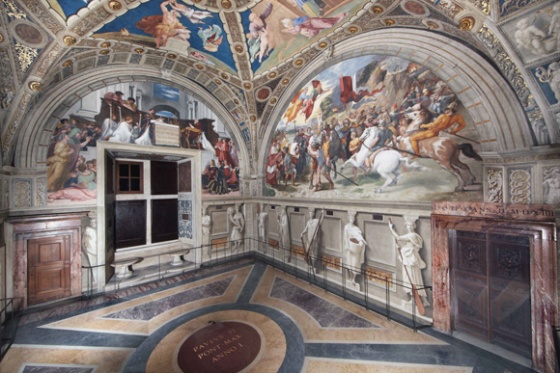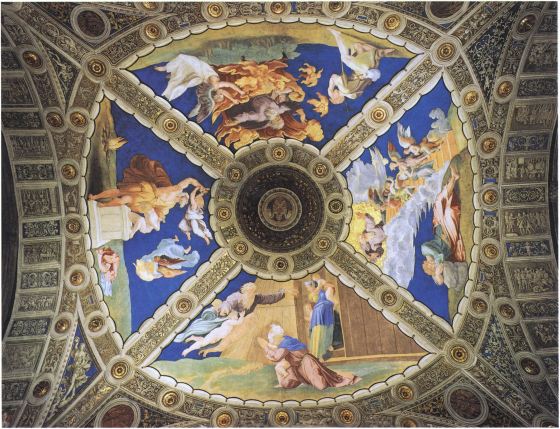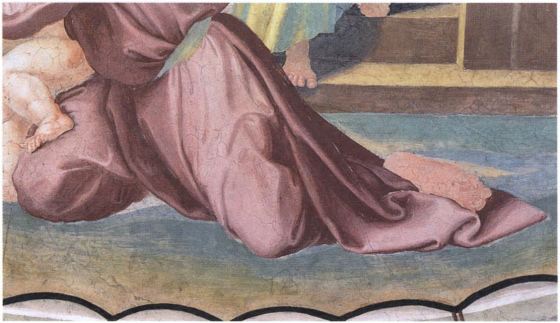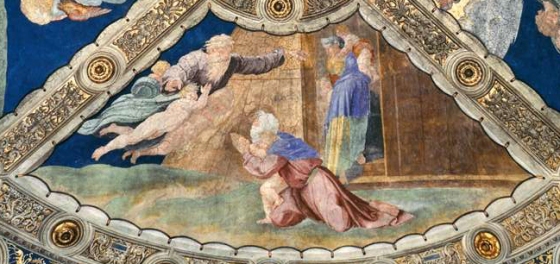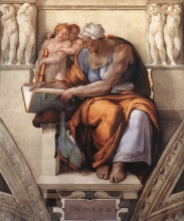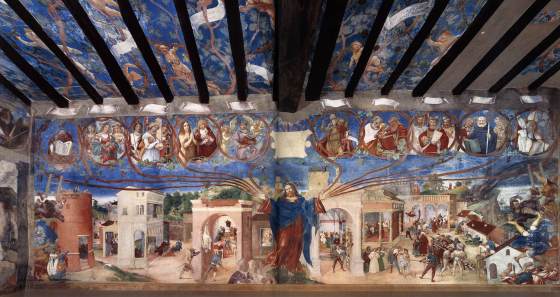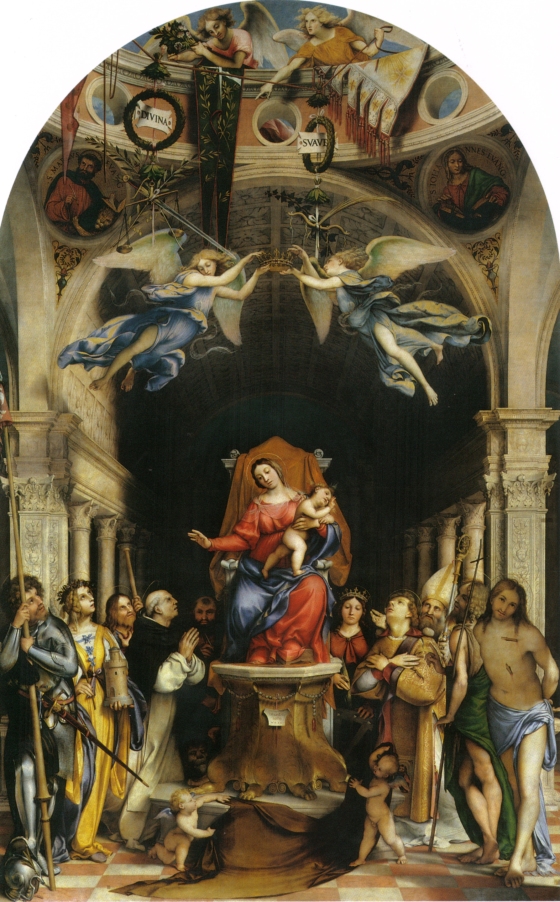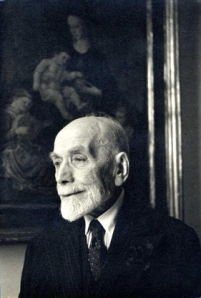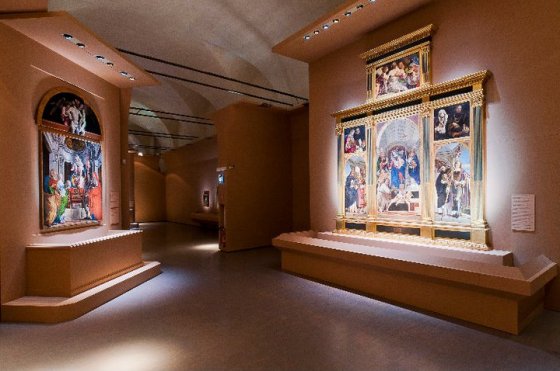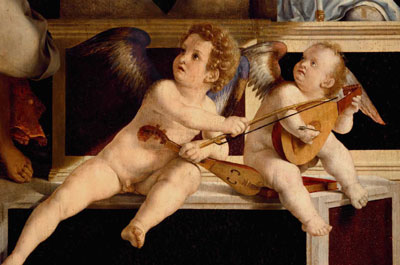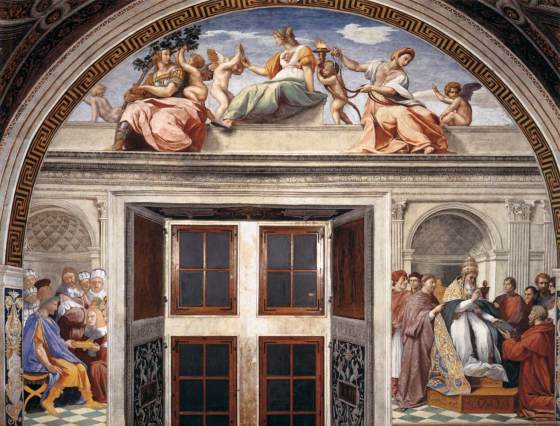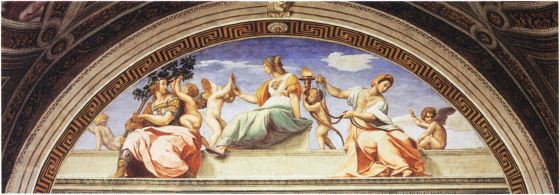In the previous post we have seen that Lorenzo Lotto (c. 1480-1556/7) worked with Raphael Santi on the papal apartments in the Vatican some time after 1509 when he received advance payments for work still to be carried out. But how long did he stay in Rome? So far it has been assumed that the commission for the Colleoni Martinengo altarpiece in Bergamo for which he signed the contract in 1513 meant that he had left Rome forgood. But what if he had not? Are there more frescos in the Vatican Stanze that could possibly be identified as his?
Stanza di Eliodoro
It has recently been suggested that, apart from the Pandects fresco in the Stanza della Segnatura, Lotto’s hand can also be detected in the central vault of the Stanza di Eliodoro (Figs. 1 and 2). Raphael Santi started work here after the room had already undergone significant changes. A chronology of the decorations of this room too complicated to outline here, but in 1511 no one could have foreseen that the patron of the project, Julius II, would die two years later and that his successor, the Medici pope Leo X, would order various alterations. For instance, while Julius’ coat of arms and inscriptions with his name remained above the spandrels, the central part of the vault was modified from eight sectors to four, each twice the size of the original eight sectors. It is that new vault that concerns us here.
Fictive tapestries?
The general theme of the room, specifically developed for Pope Julius, is that of God’s intervention in human destiny. The central vault presents episodes of divine intervention in the history of Israel (the Moses and the Burning Bush, the Announcement of the Flood to Noah, Jacob’s Dream and the Sacrifice of Isaac) for which, as in the case of the Pandects, Raphael made the designs. Stylistically the vault has puzzled people ever since the 17th century when the attribution to Raphael was already questioned. Since the discovery of Raphael’s preparatory drawings (Fig. 4) and taking into account the rare cartoon fragment for the figure of Moses in Moses and the Burning Bush (Fig. 3), Raphael’s authorship was generally accepted half a century ago.
The difference in appearance between the vault and the other frescos in the room was ingeniously explained by assuming that they are “fictive tapestries”. It is certainly peculiar that the scenes seem to be bordered by painted ropes, as if they are textiles attached to the ceiling by means of a noose. See, for instance, a detail from the Noah fresco (Fig. 5). But that still does not mean that Raphael painted them.
Dating the vault
The colossal figures and the colour scheme of the vault frescos are based on Michelangelo’s Sistine ceiling. In particular the colori cangianti of Noah’s wife (Fig. 6) recall figures such as the seated woman in the lunette of Michelangelo’s Achim and Eliud and her cap resembles that of the Cumaean Sibyl (Fig. 7) while God the Father, with his fluttering green drapery and large attendant putti is adapted from Michelangelo’s vision of God in the Creation of Adam (Fig. 8), suggesting that the planning and execution of the Eliodoro vault postdated October 1512 when the ceiling of the Sistine Chapel was unveiled.
A preparatory drawing for the vault scene of Moses and the Burning Bush (Fig. 9) provides a clue for another date: on the same sheet are several architectural sketches.
When Bramante died in 1514 it was Raphael who succeeded him as the new architect of St Peter’s and the architectural drawings may relate to his new task. They are dated by Oberhuber between 1 April and 1 August 1514. Since Raphael seems to have finished work in the Stanza di Eliodoro and had started work on the Stanza dell’Incendio by 1 July 1514, it seems that the “fictive tapestries” date from this period.
Identifying Lotto’s hand
Already in 1926 and 1931 it was suggested by scholars that the Eliodoro vault was painted by the same hand as Tribonian presenting the Pandects to the Emperor Justinian in the Stanza della Segnatura (see previous post) and following the recent restoration, which allowed for a more thorough analysis, there appears to be more evidence to support this theory. The vault’s extensive areas of a single colour seem to reduce the volume usual in Raphael’s figures and although the monumentality of the figures and details such as the heads of the putti and that of God the Father conform with Raphael’s style, the colour scheme and the application of the colours does not. For instance, the well-preserved blue backgrounds are reminiscent of Lotto’s later fresco of Christ the Vine in Trescore’s Oratorio Suardi (Fig. 10).
In addition, the present condition of the Eliodoro vault corresponds with what we have seen in the Pandects: the colours are applied in layers rather than being modelled tonally and the pigments have carbonised less in the upper layers resulting in paint losses. The upper layers have become so brittle that mere rubbing of the surface has a considerable influence on their appearance.
Heads such as that of Jacob in Jacob’s Dream (Fig. 12) and those of the judges in the Pandects (Fig. 11) resemble each other in the way the faces are modelled by a kind of rouge applied to their cheeks on top of the base fleshtones. The painter created contours in a very personal and distinctive manner by leaving a fine, thin line of the grey plaster to appear between two areas of colour.
This is also evident when one compares facial tonalities and painterly treatment of, for instance, Lotto’s head of a putto from Moses and the Burning Bush and a Raphael putto from the Stanza della Segnatura (Figs. 13 and 14).
Glaring eyes underlined with red brushstrokes, such as those of the son embraced by Noah (Fig. 16) in the vault, also occur in the figure of Lotto’s Cimmerian Sibyl (Fig. 15) at Trescore.
It is characteristic of Lotto that all his children and angels are blond. This applies even to God the Father in the Noah scene, who is depicted with fair hair (see Fig. 2).
When did Lotto leave Rome?
If we accept that Lorenzo Lotto painted the vault of the Stanza di Eliodoro, that brings us the problem of the painter’s itinerary. From his early works which can be dated with certainty, either because he signed and dated them himself or because the contracts for them have survived, we know, for instance, that he started painting the Entombment of Christ for San Floriano in Jesi on 27 October 1511 and started work on the Colleoni Martinengo altarpiece (Fig. 17) for the church of Santo Stefano in Bergamo on 15 May 1513. This magnificent and monumental altarpiece took three years to finish: it is signed 1516. In fact, it was the largest altarpiece Lotto ever painted: its central panel, a Sacra Conversazione, measuring 520 x 250 cm.
Even at this size, three years seems rather long to complete an altarpiece. Was Lotto, having moved to Bergamo, summoned to Rome again in 1514 to assist Raphael on the Stanza di Eliodoro? Had he heard of Bramante’s death that year and had travelled to Rome on his own initiative in the hope of taking over direction from Raphael in the papal rooms? Or did he not leave Rome at all? Lotto’s signature on his dated pictures in Jesi and Recanati does not prove where they were painted, whether on site or in a Roman studio from where they were sent to their final destination as was done during the years when Lotto lived in Venice.
Until now, Lorenzo Lotto’s activity in Rome could be reconstructed only from the two payments for his work in the Stanze in 1509 and from a drawing attributed to him of the ancient sculptural group of Hercules and Antaeus in the Belvedere statue court. If Lotto intended from the start to paint the Colleoni Martinengo altarpiece in Bergamo, it meant that he must have returned to Rome in 1514, perhaps to collect his belongings and pack up his studio, and was engaged there briefly by Raphael to paint the Eliodoro vault, something that could be done in a relatively short time.
For some of the figures in the Colleoni Martinengo altarpiece Lotto seems to have drawn inspiration from Raphael’s design for the Eliodoro vault, but rather than relying on the finished mural, he may have used Raphael’s autograph preparatory sketches, especially that for Moses and the Burning Bush. If Lotto stayed in Rome, he presumably got to know the Stanze intimately between 1513 and 1516. He may even have used two drawings by Raphael of Victories from the Arch of Titus in the Roman Forum (Fig. 18) for his pair of angels in the altarpiece, particularly their draperies and their bare legs (Fig. 19).
It is tempting to think that Lotto must have returned to Rome after he signed the contract in Bergamo, at least for a short period. If in fact it was he who executed the fictive tapestries on the vault and was therefore became, at least temporarily, a member of Raphael’s workshop, his deep knowledge of Raphael’s frescos for the Stanze is not surprising. Of course this is conjecture at this point. Further dedicate research in Rome’s archives or a chance archival find there might one day provide further answers.
One thing is clear: the collaboration with Raphael Santi left a lasting impression on Lorenzo Lotto. In the rivalry that existed between Michelangelo and Raphael, Lotto belonged firmly in the latter’s camp. Michelangelo’s frescos seem to have made little impression on him, nor, for that matter, did the antiquities and architecture of Rome, none of which appear in his post-Rome paintings and antiquities only as props in the portrait of the collector Andrea Odoni, no doubt at Odoni’s request. The only reference to Rome’s architecture in Lotto’s paintings is in a small panel depicting Saint Jerome (Fig. 22), which Lotto painted in Rome, probably in 1509 judging from its partially legible date. The large circular building in it has been identified as Castel Sant’ Angelo where the panel is still kept today. But the figure of the Saint is derived from Raphael’s reclining figure of Diogenes in the School of Athens fresco in the Vatican palace (Fig. 20) while the head appears based on Raphael’s Saint Jerome in the Disputation of the Holy Sacrament fresco (Fig. 21). Because of these rather self-conscious borrowings, I think Lotto intended the panel as a homage to Raphael.
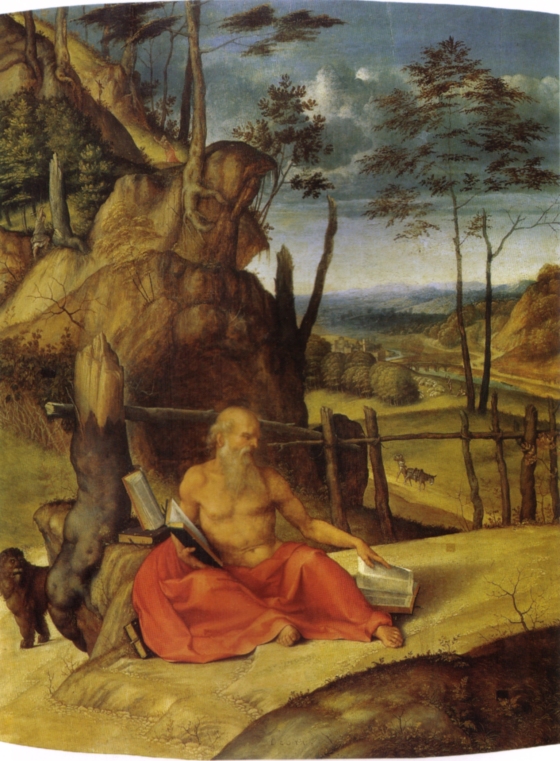
22. Lorenzo Lotto, Saint Jerome in the Wilderness, c. 1509, oil on panel 80.5 x 61 cm, Museo Nazionale di Castel Sant’ Angelo, Rome
Selected literature:
For selected literature I refer to the previous post.

